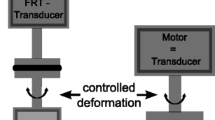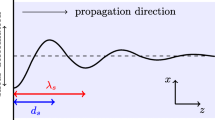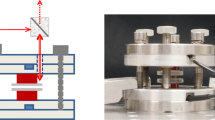Abstract
The two aims of this publication are to introduce a new and rheometer-independent rheometric tool for measuring the axial normal force in oscillatory shear rheology and to study the normal forces of polyolefin melts under large amplitude oscillatory shear (LAOS). A new plate geometry with an incorporated highly sensitive piezoelectric normal force sensor was designed for a rotational rheometer. The new geometry was used to investigate normal forces of polyethylene (PE) melts under LAOS. The resulting stress and normal force data was compared with the data from measurements in commercial high performance rotational rheometers. The stress and the normal force response were Fourier-transformed and their resulting spectra were analysed. The non-linear contributions to the FT-magnitude spectra (i.e. the intensities of the higher harmonics) were analysed using the framework of the Q-parameter, \(Q=I_{3/1}/{\gamma ^{2}_{0}}\) for both the stress spectrum and the normal force spectrum, resulting in the strain-dependent \(Q\left (\gamma _{0}\right )\) and \(Q_{NF}\left (\gamma _{0}\right )\), respectively. The newly designed normal force geometry had a sensitivity in the measurement starting from \(5\times 10^{-5}\) N up to 20 N, and respectively a signal-to-noise ratio (SNR) of \(1:\) 16.000, which is about a factor of 1.8 times better than the best performing commercial rheometers. The new geometry was used to determine \(Q\left (\gamma _{0}\right )\) and \(Q_{NF}\left (\gamma _{0}\right )\), to characterize the shear rheological behaviour of the PE melts. Even rather simple rheometers, those without normal force detection, can be extended utilizing the here presented tools for high sensitive FT-rheology analysing the normal forces.









Similar content being viewed by others
Notes
It was first commercialised with the ARES G2 from TA-instruments.
This depends strongly on the sample type and the concentration.
The torque sensitivity is specified by the manufacturer to be between 0.002 - 200 mNm; respectively 5 decades.
The normal force is specified by the manufacturer to be between 0.02 - 20 N; respectively 3 decades.
Torque sensitivity as specified by the manufacturer: 0.05 μNm - 200 mNm; respectively 6 decades. Normal force sensitivity as specified by the manufacturer: 0.001 N - 20 N; respectively 4 decades.
\(\overline {M}_{w}\): weight averaged molecular weight, \(\overline {M}_{n}\): number averaged molecular weight, PDI: polydispersity index, \(T_{m}\): melting temperature
In a second design, the amount of screws was reduced to three to reduce weight and assembly work.
In the following the term time-dependent shear stress is shortened to shear stress, because no other dependence was studied in this article. A similar abbreviation is used for the time-dependent normal force.
This is known under the term of oversampling and is a crucial tool to significantly improve the signal to noise ratio.
The definition of \(Q_{NF}\) will be given later in this article (“Non-linear parameters from the FT-measurement”).
The excitation frequency is identical with the frequency of the first harmonic of the Fourier transform spectrum, ν0 ≡ ν1 = n ⋅ ν0,for n = 1. In the following equations and data analysis the angular frequency \(\omega \) is substituted by \(\nu \times 2\pi \), because \(\nu \) uses the units of 1/s instead of rad/s.
The quantities obtained from the measurement of the time-dependent behaviour are, e.g. moduli, viscosity or torque.
The manufacturer (TA-Instruments) claims only a sensitivity of \(10^{-3}\) N.
References
Baek S-G, Magda JJ (2003) Monolithic rheometer plate fabricated using silicon micromachining technology and containing miniature pressure sensors for N1 and N2 measurements. J Rheol 47(5):1249–1260
Bracewell RN (1965) The Fourier transform and its applications. McGraw-Hill, New York
Carotenuto C, Grosso M, Maffettone PL (2008) Fourier transform rheology of dilute immiscible polymer blends A novel procedure to probe blend morphology. Macromolecules 41(12):4492–4500
Cziep MA, Abbasi M, Heck M, Arens L, Wilhelm M (2016) Effect of molecular weight, polydispersity, and monomer of linear homopolymer melts on the intrinsic mechanical nonlinearity \({~}^{3}\!\text {q}0(\omega )\) in MAOS. Macromolecules 49(9):3566–3579
Debbaut B, Burhin H (2002) Large amplitude oscillatory shear and fourier-transform rheology for a high-density polyethylene: experiments and numerical simulation. J Rheol 46(5):1155–1176
Dodge JS, Krieger IM (1971) Oscillatory shear of nonlinear fluids I. preliminary investigation. Trans Soc Rheol 15(4):589–601
Doeblin EO, Manik DN (2011) Measurement systems. Tata McGraw-Hill, New Delhi
Gahleitner M (2001) Melt rheology of polyolefins. Prog Polym Sci 26(6):895–944
Giacomin AJ, Oakley JG (1992) Structural network models for molten plastics evaluated in large-amplitude oscillatory shear. J Rheol 36(8):1529–1546
Giacomin AJ, Jeyaseelan RS, Samurkas T, Dealy JM (1993) Validity of separable BKZ model for large-amplitude oscillatory shear. J Rheol 37(5):811–826
Gleissle W (1974) Schub- und Normalspannungsmessungen an silikonölen bei hohen Schergefällen mit einem neuen Kegel-Platte-Rheometer. Colloid Polym Sci 252(10):848–853
Gleissle W, Ohl N (1990) On the relaxation of shear and normal stresses of viscoelastic fluids following constant shear rate experiments. Rheol Acta 29(4):261–280
Gleissle W, Reichert H (1973) Kurzzeit-Rotations-Rheometer zur Messung von hohen Schub- und Normalspannungen bei grossen Schergefällen. Rheol Acta 12(4):572–577
Graham MD (1995) Wall slip the nonlinear dynamics of large amplitude oscillatory shear flows. J Rheol 39 (4):697–712
Hatzikiriakos SG, Dealy JM (1991) Wall slip of molten high density polyethylene. I. Sliding plate rheometer studies. J Rheol 35(4):497–523
Heymann L, Peukert S, Aksel N (2002) Investigation of the solid–liquid transition of highly concentrated suspensions in oscillatory amplitude sweeps. J Rheol 46(1):93–112
Hyun K, Kim W (2011) A new non-linear parameter Q from FT-rheology under nonlinear dynamic oscillatory shear for polymer melts system Korea-Australia. Rheol J 23(4):227–235
Hyun K, Wilhelm M (2008) Establishing a new mechanical nonlinear coefficient Q from FT-rheology: first investigation of entangled linear and comb polymer model systems. Macromolecules 42(1):411–422
Hyun K, Wilhelm M (2010) Non-linear rheology of entangled linear and branched polymer melts under large amplitude oscillatory shear. Kautsch Gummi Kunstst 4:123–129
Hyun K, Wilhelm M, Klein C, Cho KS, Nam JG, Ahn KH, Lee SJ, Ewoldt RH, McKinley GH (2011) A review of nonlinear oscillatory shear tests Analysis and application of large amplitude oscillatory shear (LAOS). Prog Polym Sci 36(12):1697– 1753
Jeyaseelan RS, Giacomin AJ (1993) Best fit for differential constitutive model parameters to nonlinear oscillation data. J Non-Newtonian Fluid Mech 47:267–280
Kempf M (2011) Synthesis and rheology of model comb polymer architectures. PhD thesis, Karlsruhe Institute of Technology (KIT)
Kempf M, Barroso VC, Wilhelm M (2010) Anionic synthesis and rheological characterization of poly(p-methylstyrene) model comb architectures with a defined and very low degree of long chain branching. Macromol Rapid Commun 31(24):2140–2145
Klein C (2005) Rheology and fourier-transform rheology on water-based systems. PhD thesis, Johannes Gutenberg University Mainz
Klein C, Naue IFC, Nijman J, Wilhelm M (2009) Addition of the force measurement capability to a commercially available extensional rheometer (caBER). Soft Mater 7(4):242–257
Klimke K, Parkinson M, Piel C, Kaminsky W, Spiess H-W, Wilhelm M (2006) Optimisation and application of polyolefin branch quantification by melt-state \(_{13}\)C NMR spectroscopy. Macromol Chem Phys 207(4):382–395
Komatsu H, Mitsui T, Onogi S (1973) Nonlinear viscoelastic properties of semisolid emulsions. Trans Soc Rheol 17(2):351–364
Kröger M (2004) Simple models for complex nonequilibrium fluids. Phys Rep 390(6):453–551
Laun HM (1978) Description of the non-linear shear behaviour of a low density polyethylene melt by means of an experimentally determined strain dependent memory function. Rheol Acta 17(1):1–15
Liu J, Lou L, Yu W, Liao R, Li R, Zhou C (2010) Long chain branching polylactide: structures and properties. Polymers 51(22):5186–5197
Lodge AS (1989) An attempt to measure the first normal-stress difference N1 in shear flow for a polyisobutylene/decalin solution D2b at shear rates up to 106 \(s^{-1}\). J Rheol 33(6):821–841
Lohse DJ, Milner ST, Fetters LJ, Xenidou M, Hadjichristidis N, Mendelson RA, Garcia-Franco CA, Lyon MK (2002) Well-defined, model long chain branched polyethylene. 2. melt rheological behavior. Macromolecules 35(8):3066–3075
Matsumoto T, Segawa Y, Warashina Y, Onogi S (1973) Nonlinear behavior of viscoelastic materials. III. The method of analysis and temperature dependence of nonlinear viscoelastic functions. Trans Soc Rheol 17(1):47–62
Merger D, Wilhelm M (2014) Intrinsic nonlinearity from LAOStrain experiments on various strain- and stress-controlled rheometers: a quantitative comparison. Rheol Acta 53(8):621–634
Münstedt H, Laun HM (1979) Elongational behaviour of a low density polyethylene melt. Rheol Acta 18 (4):492–504
Münstedt H, Laun HM (1981) Elongational properties and molecular structure of polyethylene melts. Rheol Acta 20(3):211–221
Nam JG, Hyun K, Ahn KH, Lee SJ (2008) Prediction of normal stresses under large amplitude oscillatory shear flow. J Non-Newtonian Fluid Mech 150(1):1–10
Nam JG, Ahn KH, Lee SJ, Hyun K (2010) First normal stress difference of entangled polymer solutions in large amplitude oscillatory shear flow. J Rheol 54(6):1243–1266
Neidhöfer T, Wilhelm M, Debbaut B (2003) Fourier-transform rheology experiments and finite-element simulations on linear polystyrene solutions. J Rheol 47(6):1351–1371
Oakley JG, Giacomin AJ (1994) A sliding plate normal thrust rheometer for molten plastics. Polym Eng Sci 34(7):580–584
Onogi S, Masuda T, Matsumoto T (1970) Non-linear behavior of viscoelastic materials. I. disperse systems of polystyrene solution and carbon black. Trans Soc Rheol 14(2):275–294
Philippoff W (1966) Vibrational measurements with large amplitudes. J Rheol 10(1):317–334
Sagis LMC, Ramaekers M, van der Linden E (2001) Constitutive equations for an elastic material with anisotropic rigid particles. Phys Rev E 63(5):051504
Schweizer T (2002) Measurement of the first and second normal stress differences in a polystyrene melt with a cone and partitioned plate tool. Rheol Acta 41(4):337–344
Schweizer T (2003) Comparing cone-partitioned plate and cone-standard plate shear rheometry of a polystyrene melt. J Rheol 47(4):1071–1085
Schweizer T, Bardow A (2006) The role of instrument compliance in normal force measurements of polymer melts. Rheol Acta 45(4):393–402
Shaw MT (2012) Introduction to polymer rheology. Wiley, Hoboken
Sim HG, Ahn KH, Lee SJ (2003) Three-dimensional dynamics simulation of electrorheological fluids under large amplitude oscillatory shear flow. J Rheol 47(4):879–895
Strobl G (2007) The physics of polymers: concepts for understanding their structure and behaviour. Springer, Berlin
Tee T-T, Dealy JM (1975) Nonlinear viscoelasticity of polymer melts. Trans Soc Rheol 19(4):595–615
van Dusschoten D, Wilhelm M (2001) Increased torque transducer sensitivity via oversampling. Rheol Acta 40(4):395–399
Vega J, Aguilar M, Peon J, Pastor D, Marnez-Salazar J (2002) Effect of long chain branching on linear-viscoelastic melt properties of polyolefins. e-Polymer 2:624
Vittorias IA (2006) Fourier-transform rheology applied on homopolymer melts of different architectures- experiments and finite element simulation. PhD thesis, TUD - Technical University Darmstadt
Wagner MH, Bastian H, Bernnat A, Kurzbeck S, Chai CK (2002) Determination of elongational viscosity of polymer melts by rme and rheotens experiments. Rheol Acta 41(4):316–325
Wilhelm M (2002) Fourier-transform rheology. Macromol Mater Eng 287(2):83–105
Wilhelm M, Maring D, Spiess H-W (1998) Fourier-transform rheology. Rheol Acta 37(4):399–405
Wilhelm M, Reinheimer P, Ortseifer M (1999) High sensitivity fourier-transform rheology. Rheol Acta 38:349–356
Wilhelm M, Reinheimer K, Kübel J (2012) Optimizing the sensitivity of FT-rheology to quantify and differentiate for the first time the nonlinear mechanical response of dispersed beer foams of light and dark beer. Z Phys Chem 226:547
Acknowledgments
The authors want to thank Dr. C.O. Klein for his preliminary work with the CaBER, see Klein et al. (2009) and D. Zimmermann for his support at the ARES measurements. Furthermore, the authors want to thank, Dr. I. Vittorias from LyondellBASELL, Dr. S.A. Filipe from Borealis and Prof. H. Münstedt for providing some of the samples. The authors are grateful to Dr. D. Merger, Dr. M. Abbasi and, especially, Dr. J. Kübel for proofreading the manuscript.
Author information
Authors and Affiliations
Corresponding author
Additional information
Publisher’s Note
Springer Nature remains neutral with regard to jurisdictional claims in published maps and institutional affiliations.
Rights and permissions
About this article
Cite this article
Naue, I.F.C., Kádár, R. & Wilhelm, M. High sensitivity measurements of normal force under large amplitude oscillatory shear. Rheol Acta 57, 757–770 (2018). https://doi.org/10.1007/s00397-018-1111-y
Received:
Revised:
Accepted:
Published:
Issue Date:
DOI: https://doi.org/10.1007/s00397-018-1111-y




